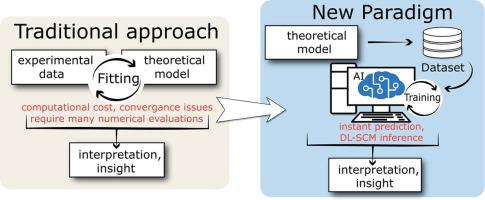当前位置:
X-MOL 学术
›
Comp. Mater. Sci.
›
论文详情
Our official English website, www.x-mol.net, welcomes your feedback! (Note: you will need to create a separate account there.)
Deep neural network surrogate for surface complexation model of metal oxide/electrolyte interface
Computational Materials Science ( IF 3.3 ) Pub Date : 2024-03-15 , DOI: 10.1016/j.commatsci.2024.112932 Chunhui Li , Steven Farrell , Benjamin Gilbert , Piotr Zarzycki
Computational Materials Science ( IF 3.3 ) Pub Date : 2024-03-15 , DOI: 10.1016/j.commatsci.2024.112932 Chunhui Li , Steven Farrell , Benjamin Gilbert , Piotr Zarzycki

|
Surface Complexation Models (SCM) are one of the most successful geochemical thermodynamics models of the speciation and charging of the mineral/electrolyte interface. However, finding unique and transferable SCM parameter values by fitting experimental data using existing numerical solvers is often challenging. We hypothesized that SCM surrogates built using Artificial Intelligence algorithms provide an alternative strategy for determining model parameter values and thus offer an ultrafast prediction of electrical double layer characteristics of metal oxide/electrolyte interface. We generated synthetic datasets of surface charge and electrokinetic potential as a function of pH, ionic strength, varying site densities, acidity, and ion-affinities of mineral surfaces using the 2-pK Triple Layer Model - one of the most used generic SCM. We explored a wide range of types of mineral surfaces using random walks in the parameter space. Next, we trained and validated two AI surrogates using our synthetic SCM data. We showed that AI-SCM surrogates for oxide/electrolyte interfaces are possible and cost-effective. They allow ultrafast and accurate SCM parametrization using synthetic data. AI-SCM can predict thermodynamic parameters from just a few titration data points, such as ion affinities and proton binding constants. What is more, the computational strategy we presented here to surrogate geochemical models by pre-trained AI architectures is more universal and can be applied to other geochemical/thermodynamic models – replacing the computationally expensive solvers with trained AI, thus minimizing computing costs and speeding up data analysis.
中文翻译:

深度神经网络替代金属氧化物/电解质界面的表面络合模型
表面络合模型 (SCM) 是矿物/电解质界面形态形成和充电最成功的地球化学热力学模型之一。然而,通过使用现有数值求解器拟合实验数据来找到独特且可转移的 SCM 参数值通常具有挑战性。我们假设使用人工智能算法构建的 SCM 替代物提供了一种确定模型参数值的替代策略,从而提供金属氧化物/电解质界面的双电层特性的超快速预测。我们使用 2-pK 三层模型(最常用的通用 SCM 之一)生成了表面电荷和动电势的合成数据集,作为矿物表面 pH、离子强度、不同位点密度、酸度和离子亲和力的函数。我们使用参数空间中的随机游走探索了多种类型的矿物表面。接下来,我们使用合成的 SCM 数据训练和验证了两个 AI 代理。我们证明了氧化物/电解质界面的 AI-SCM 替代品是可行的且具有成本效益。它们允许使用合成数据进行超快速且准确的 SCM 参数化。 AI-SCM 可以从几个滴定数据点预测热力学参数,例如离子亲和力和质子结合常数。更重要的是,我们在这里提出的通过预先训练的人工智能架构来替代地球化学模型的计算策略更加通用,可以应用于其他地球化学/热力学模型——用训练有素的人工智能取代计算成本高昂的求解器,从而最大限度地降低计算成本并加快速度数据分析。
更新日期:2024-03-15
中文翻译:

深度神经网络替代金属氧化物/电解质界面的表面络合模型
表面络合模型 (SCM) 是矿物/电解质界面形态形成和充电最成功的地球化学热力学模型之一。然而,通过使用现有数值求解器拟合实验数据来找到独特且可转移的 SCM 参数值通常具有挑战性。我们假设使用人工智能算法构建的 SCM 替代物提供了一种确定模型参数值的替代策略,从而提供金属氧化物/电解质界面的双电层特性的超快速预测。我们使用 2-pK 三层模型(最常用的通用 SCM 之一)生成了表面电荷和动电势的合成数据集,作为矿物表面 pH、离子强度、不同位点密度、酸度和离子亲和力的函数。我们使用参数空间中的随机游走探索了多种类型的矿物表面。接下来,我们使用合成的 SCM 数据训练和验证了两个 AI 代理。我们证明了氧化物/电解质界面的 AI-SCM 替代品是可行的且具有成本效益。它们允许使用合成数据进行超快速且准确的 SCM 参数化。 AI-SCM 可以从几个滴定数据点预测热力学参数,例如离子亲和力和质子结合常数。更重要的是,我们在这里提出的通过预先训练的人工智能架构来替代地球化学模型的计算策略更加通用,可以应用于其他地球化学/热力学模型——用训练有素的人工智能取代计算成本高昂的求解器,从而最大限度地降低计算成本并加快速度数据分析。



























 京公网安备 11010802027423号
京公网安备 11010802027423号